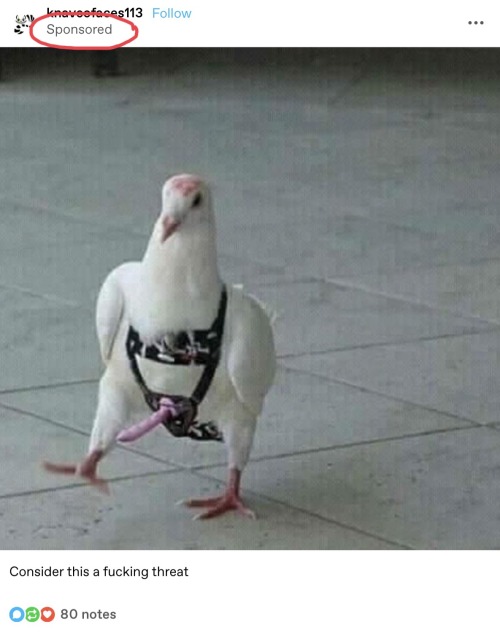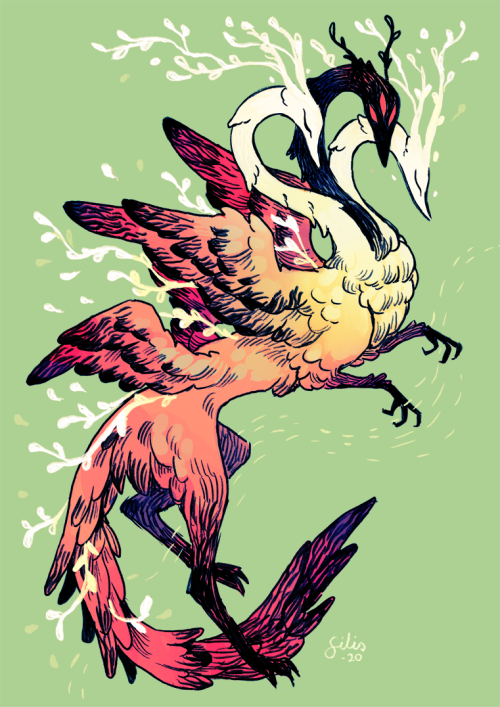Your Gender Is Clearly Bird 🙄
your gender is clearly bird 🙄

More Posts from Eggxecutive-dysfunction and Others







Inktober 2021 by Gregory Fromenteau
@歷蜀記Lishuji
🍲火鍋底料 hot pot base
Is there a bird out there that looks remotely SciFi 🤔 there's gotta be one fella out there with some pattern on them...
So I think you probably want a very futuristic spacey bird, but I'd also like to add some fellas that could easily wander on and about on some alien world and totally fit in Let’s do a list thingy! Four sci-fi birds, whether it’s because they look alien, like a spacecraft or just generally fit the vibe!
1. The Black heron

The black heron, is a member of the Ardeidae occurring in Africa, well known for its peculiar feeding habit, which professionally is referred to as “canopy feeding”. When it does that it uses its wings like an umbrella, creating shade and in turn attracting fish and other prey items. More importantly, its metallic plumage makes it look like a funky UFO.
2. The Andean cock-of-the-rock

First of all here’s what some journalist has to say on these birds (ʰᶦⁿᵗ: ᵗʰᵉʸ’ʳᵉ ʳᶦᵍʰᵗ)

Now, there’s so much to say about cocks-of-the-rock; why they’re called that, why they sound so weird, whatever is going on with their head? Let’s only focus only the latter for this one. First of all, Andean cocks-of-the-rock are sexually dimorphic and while females still look weird, it’s much less extreme on them than it is with males. The thing on their head is a crest, much like that of a tufted titmouse or Eurasian hoopoe, just that it’s shaped like a disk. Overall they’re just fantastic aliens.
3. Any Hornbill

The “horn” on the huge beak of a hornbill, called a casque (not to be confused with the cacique) is there to add strength and/or counterweight to the bills (which is needed, or at the very least helpful when chiselling in bark or hard soil), sometimes also acting as sound chambers to augment vocalisations. Also, considering that casques are usually larger on males than they are on females, and that they can take several years to reach full size, they may be a sign of sexual maturity or status. This - in addition to the many colours a hornbill can have and the wattle makes earth look quite ✨extra-terrestrial✨ (ʸᵉˢ ᴵ ᵏⁿᵒʷ ᵗʰᵃᵗ ᶦˢ ᶜᵒⁿᵗʳᵃᵈᶦᶜᵗᵒʳʸ).
4. The Metallic starling

The metallic starling is an Australasian bird that from a far may seem like just another black bird, however given the right angle and light they show a stunning array of purple and green iridescence. Another very notable feature are their brilliant black eyes. Definitively very spacey, 10/10 birds, would take over a planet if they’d were to try.

Also you asked for patterns! I didn’t include them but perhaps, golden pheasants, sunbitterns or wilson's bird-of-paradise could be of interest to you!

Photo credits: ATLAS1GP, ryanacandee, Bernard DUPONT, Leon Molenaar, TOONMAN_blchin, Jim Boud, cuatrok77, Art G.
Sources: Audubon Society - Watch a Black Heron Fool Fish by Turning Into an Umbrella, Wikipedia The Free Encyclopaedia - Andean cock-of-the-rock, Birdwatching: Your source of becoming a better birder - Julie Craves explains the purpose of hornbills’ huge bills, San Diego Zoo Wildlife Alliance Animals & Plants - Metallic Starling
![“Reconsidering The Pigeon” - Photographs By Leila Jeffreys [via]](https://64.media.tumblr.com/0d5715e3f7b8af73f1fb75c88bcb7510/tumblr_p0txxhghyi1qf9q3lo1_500.jpg)
![“Reconsidering The Pigeon” - Photographs By Leila Jeffreys [via]](https://64.media.tumblr.com/0bce75082f18517089139ca7cc0f3b53/tumblr_p0txxhghyi1qf9q3lo6_500.jpg)
![“Reconsidering The Pigeon” - Photographs By Leila Jeffreys [via]](https://64.media.tumblr.com/aca4d520639b3e8f09e774939be47748/tumblr_p0txxhghyi1qf9q3lo8_500.jpg)
![“Reconsidering The Pigeon” - Photographs By Leila Jeffreys [via]](https://64.media.tumblr.com/73ce161fc9d2cab2f259445c5d8ef6bd/tumblr_p0txxhghyi1qf9q3lo4_500.jpg)
![“Reconsidering The Pigeon” - Photographs By Leila Jeffreys [via]](https://64.media.tumblr.com/7759bc641f6a9ee0883498d85906fb1b/tumblr_p0txxhghyi1qf9q3lo3_500.jpg)
![“Reconsidering The Pigeon” - Photographs By Leila Jeffreys [via]](https://64.media.tumblr.com/72295b0a078ae6f72c1a47b0853cc79b/tumblr_p0txxhghyi1qf9q3lo5_500.jpg)
![“Reconsidering The Pigeon” - Photographs By Leila Jeffreys [via]](https://64.media.tumblr.com/cc0c5aaf6b5925ee29bf2d837cb4574a/tumblr_p0txxhghyi1qf9q3lo10_500.jpg)
![“Reconsidering The Pigeon” - Photographs By Leila Jeffreys [via]](https://64.media.tumblr.com/18e9b0846b99ee94fba0c5aea3242d07/tumblr_p0txxhghyi1qf9q3lo2_500.jpg)
![“Reconsidering The Pigeon” - Photographs By Leila Jeffreys [via]](https://64.media.tumblr.com/aabd63d8479741993717034c1a14eb1e/tumblr_p0txxhghyi1qf9q3lo7_500.jpg)
![“Reconsidering The Pigeon” - Photographs By Leila Jeffreys [via]](https://64.media.tumblr.com/7cbbdc70da5dc6f38a40f774eaa1d582/tumblr_p0txxhghyi1qf9q3lo9_500.jpg)
“Reconsidering The Pigeon” - photographs by Leila Jeffreys [via]

Gray Catbird (Dumetella carolinensis)
© Kyle Jones

I’m never leaving this website

The Ghoul of IC 2118 : Inspired by the halloween season, this telescopic portrait captures a cosmic cloud with a scary visage. The interstellar scene lies within the dusty expanse of reflection nebula IC 2118 in the constellation Orion. IC 2118 is about 800 light-years from your neighborhood, close to bright bluish star Rigel at the foot of Orion. Often identified as the Witch Head nebula for its appearance in a wider field of view it now rises before the witching hour though. With spiky stars for eyes, the ghoulish apparition identified here seems to extend an arm toward Orion’s hot supergiant star. The source of illumination for IC 2118, Rigel is just beyond this frame at the upper left. via NASA

black swan and her sisters
-
 vurrsys reblogged this · 1 year ago
vurrsys reblogged this · 1 year ago -
 theperpetualartist reblogged this · 3 years ago
theperpetualartist reblogged this · 3 years ago -
 morning-channel-static liked this · 3 years ago
morning-channel-static liked this · 3 years ago -
 deathswretch reblogged this · 3 years ago
deathswretch reblogged this · 3 years ago -
 goodnightwindy liked this · 3 years ago
goodnightwindy liked this · 3 years ago -
 lambreta-do-capeta reblogged this · 3 years ago
lambreta-do-capeta reblogged this · 3 years ago -
 sparklesphobia liked this · 3 years ago
sparklesphobia liked this · 3 years ago -
 sagdustcrusaders liked this · 3 years ago
sagdustcrusaders liked this · 3 years ago -
 mrs-ephemeral reblogged this · 3 years ago
mrs-ephemeral reblogged this · 3 years ago -
 mrs-ephemeral liked this · 3 years ago
mrs-ephemeral liked this · 3 years ago -
 michael-beeloved liked this · 3 years ago
michael-beeloved liked this · 3 years ago -
 lesbianmikuu liked this · 3 years ago
lesbianmikuu liked this · 3 years ago -
 shadows-come-early reblogged this · 3 years ago
shadows-come-early reblogged this · 3 years ago -
 shadows-come-early liked this · 3 years ago
shadows-come-early liked this · 3 years ago -
 rat---king reblogged this · 3 years ago
rat---king reblogged this · 3 years ago -
 rat---king liked this · 3 years ago
rat---king liked this · 3 years ago -
 candicelizabeth liked this · 3 years ago
candicelizabeth liked this · 3 years ago -
 royalsampaguita reblogged this · 3 years ago
royalsampaguita reblogged this · 3 years ago -
 ahsadler reblogged this · 3 years ago
ahsadler reblogged this · 3 years ago -
 procrastinationismyreligion reblogged this · 3 years ago
procrastinationismyreligion reblogged this · 3 years ago -
 devianta liked this · 3 years ago
devianta liked this · 3 years ago -
 swimmingfriendmuffinhero liked this · 3 years ago
swimmingfriendmuffinhero liked this · 3 years ago -
 autistic-dumbass reblogged this · 3 years ago
autistic-dumbass reblogged this · 3 years ago -
 autistic-dumbass liked this · 3 years ago
autistic-dumbass liked this · 3 years ago -
 hunnybel liked this · 3 years ago
hunnybel liked this · 3 years ago -
 internet-grab-my-tumblr reblogged this · 3 years ago
internet-grab-my-tumblr reblogged this · 3 years ago -
 space-batter reblogged this · 3 years ago
space-batter reblogged this · 3 years ago -
 space-batter liked this · 3 years ago
space-batter liked this · 3 years ago -
 fungus-noises liked this · 3 years ago
fungus-noises liked this · 3 years ago -
 smoooothbrain liked this · 3 years ago
smoooothbrain liked this · 3 years ago -
 coldforest reblogged this · 3 years ago
coldforest reblogged this · 3 years ago -
 paudashlake reblogged this · 3 years ago
paudashlake reblogged this · 3 years ago -
 viziertwink reblogged this · 3 years ago
viziertwink reblogged this · 3 years ago -
 viziertwink liked this · 3 years ago
viziertwink liked this · 3 years ago -
 lettingmycandleburn reblogged this · 3 years ago
lettingmycandleburn reblogged this · 3 years ago -
 eternallybutthurt reblogged this · 3 years ago
eternallybutthurt reblogged this · 3 years ago -
 glasseyedrep liked this · 3 years ago
glasseyedrep liked this · 3 years ago -
 maybeestonian liked this · 3 years ago
maybeestonian liked this · 3 years ago



